

2023 The College of Fine & Applied Arts Magazine
Stay in Touch
Email faa-advancement@illinois.edu with your feedback, updates, and stories.
Do we have your most up-to-date contact information? Don’t miss out on FAA event invitations and news – visit go.illinois.edu/UpdateFAA with your latest email and mailing address.
Co-Editors
Amy Karagiannakis
Mariana Seda (MA ’21 Theatre)
Designer
Natalie Fiol (BA ’10 LAS)
Copy Editor
Anne Jackson
Director of Communications
Andy Blacker
Associate Dean for Advancement
Jon Salvani (MS ’21 GIES)
Dean
Kevin Hamilton
Explore More Online
Visit Dimension.faa.illinois.edu for extended content and even more stories about our faculty, students, donors, and alumni. Scan the QR code now to get more FAA.

ON THE COVER
BY ANDY BLACKER
On a cool spring day, faculty, staff, and students gathered on the fourth floor of the Architecture Building for an activity that can best be described as an immersive, educational work of performance art. The participants place a hand on the shoulder of the person in front of them, close their eyes, and begin the serpentine descent downstairs led by guest artist Carmen Papalia. Instructions and warnings of obstacles and navigational challenges are shared verbally throughout the line during Papalia’s non-visual walking tour titled “Blind Field Shuttle.” The single-file line winds down five stories, up an ADA ramp from the lower level, out into the courtyard, and ends with the group gathered under the McFarland Carillon. The artwork is designed to be uncomfortable while challenging perceptions and inspiring compassion for those with other abilities and ways of being. Papalia considers the walks an equalizing gesture, introducing participants to something of potential value.
Papalia’s socially engaged art addresses access to public space, art institutions, and visual culture. Papalia describes the experience as an opportunity for the participants to unlearn visual primacy and use their non-visual senses as a primary way of knowing the world. Carmen Papalia’s visit was supported by Crip*—Cripistemology and the Arts, a research initiative within the College of Fine and Applied Arts that focuses on how knowledge produced via a Crip/Disabled experience can shape and change the way we approach our respective mediums and practices.
Learn more about the Crip* research initiative at crip.faa.illinois.edu
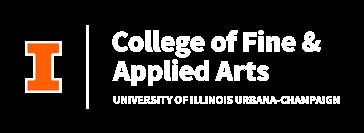

Architecture
Art & Design
Dance
Japan House
Krannert Art Museum
Krannert Center for the Performing Arts
Landscape Architecture
Music
Sustainable Design
Theatre
Urban & Regional Planning
This publication was produced by a local printer certified by the Forest Stewardship Council on recycled paper (70% postconsumer content) and using earth-friendly inks.
Cover photo and photo below by Ava Aubry (BFA 2024 Photography), student photographer for the Office of Communications and Marketing.
A MESSAGE FROM DEAN KEVIN HAMILTON
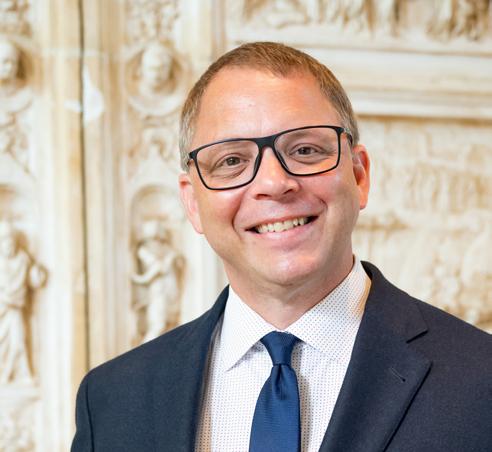
Among the questions raised by our moment’s many societal disruptions, one keeps returning for us here in FAA: are we balancing work and life appropriately and ensuring conditions for others to do the same? Many of our college’s disciplines define excellence in ways that call on makers to give everything – to “leave it all on the floor” as it were – in pursuit of beauty and revelation that only comes from risk, vulnerability, and surrender. Indeed, careers in the arts drew many of us precisely for that reason; we saw in these paths not only an invitation but a mandate to live each day fully out of passionate love for what we do. That invitation also continues to draw students to our majors and programs, especially students who transfer from other paths of study that asked them to leave parts of themselves “at the door,” instead of “on the floor.”
Unfortunately, excitement about a life lived without compromise can founder when it meets the common and pernicious lie that low wages or precarious working conditions are the justifiable price of holding a job you love. As dean, I’ve been learning from the growing number of students and other young creators rejecting that idea, rightly insisting on the importance of their craft – and indeed the importance of their personhood –through demanding equitable pay and working conditions. Like many institutions across the arts, we’re stretching here in FAA to meet those right calls through how we organize our time as well as our resources. Until we see broad structural changes in how states and corporations value and invest in the arts, we’ll be reliant on philanthropy and mutual aid to effect change at an economic level. In service of such change, we are also working to bring better data and case-making to those efforts, partnering with researchers in labor and education policy to tell challenging stories about the real and rewarding lives of creative workers in the world.
The results of alumni participation in the recent Strategic National Arts Alumni Project survey help us in that regard. For example, though only 45% of currently employed respondents report themselves as in an arts or design-related profession, 88% of all respondents feel their career is closely related to the training they received in FAA at Illinois. That difference testifies to the essential role of arts knowledge far outside our fields. Meanwhile, though a majority of employed alumni report high satisfaction with how their current work aligns with their values and allows them to contribute to society – a lower percentage are strongly optimistic about their pay, benefits, and opportunities for advancement. These and other survey results testify to work needed in the college and with our external partners to better represent the value our graduates bring to society toward improving their living and working conditions. They also affirm the work we knew was needed already to ensure that all students regardless of race, gender, ability, or economic background have an equal chance at a fulfilling vocation and life.
I invite you to read this issue of Dimension as a collection of stories of people who didn’t need data to send them to such work. You’ll see a beautiful collection of faculty, staff, and alumni who are moving to make the worlds they inhabit more reflective of what they want for themselves and others. In short, these are stories of people who want to be able to do what they love, and for others to have a chance to do the same. Indeed, you’ll read here of creators who believe that today’s broad societal disruptions call for nothing less than the proliferation of such opportunities. May we all be inspired in our own creative lives lived out of love – and especially a love that ensures that others can pursue paths like or even better than our own.
Photo by Fred Zwicky, UI Public Affairs.
Transforming Lives through Education Justice
 BY MARIANA SEDA
BY MARIANA SEDA
In 2006, Rebecca Ginsburg, associate professor of Landscape Architecture, co-founded and became the first director for the Education Justice Project (EJP), a Higher Education in Prison (HEP) program at Danville Correctional Center in Danville, Illinois. Now in its fifteenth year of programming, EJP has evolved to establish a broad network of resources and initiatives to support their students, transforming the landscape of possibilities for formerly incarcerated people.
Ginsburg’s involvement in higher education in prison stemmed from an early interest in prison abolition as a graduate student at the University of California Berkeley. She attended a meeting about teaching in San Quentin State Prison but was disappointed when abolition was not addressed. On her way out, someone approached her and asked if she was interested in teaching a course.
“I wasn’t. But I said I was because I was the only person of color in the meeting,” Ginsburg shared. “Even in the 1990s, I knew incarceration disproportionately impacted people of color. So, I can understand why she came up to me. That intervention changed my life, and it reminds me of the importance of reaching out to people.”
Under Ginsburg’s leadership, EJP expanded its initiatives beyond education to address other obstacles that formerly incarcerated people might encounter after they are released from prison. When EJP learned that many of their students were not receiving accurate information about options for their upcoming release, they got to work developing a nearly 250-page re-entry guide titled Mapping Your Future: A Guide to Successful Reentry. The guide provides advice and guidelines based on personal experiences, covering topics such as post-release expectations, reconnecting with loved ones, self-care, voting, community engagement, and sharing wisdom. Demand for the guide has skyrocketed since its first edition, and EJP now distributes thousands across Illinois and nationwide to incarcerated individuals, their families, and other HEP programs.
This increasingly holistic approach differentiates EJP from other HEP programs in the country. The program offers extracurricular programs like a mindfulness group and academic advising, and opportunities for students to write, publish, and develop their own ideas into successes, such as an award-winning ESL program and an on-campus art exhibit. Alumni of the program – those who have taken courses and are now released – are often invited to share their experiences with current students and various groups on the U of I campus and in the local community.
“
No matter how students on campus feel about this, it’s essential to introduce them to the idea that their work is political and they have agency in how they conduct themselves in the field.”
Photos provided by Rebecca Ginsburg.
Another initiative, Campus Scan, examines the challenges formerly incarcerated individuals face when navigating the University of Illinois’s employment policies and practices. The new Prison-toGown Pathway initiative aims to provide support and services for University of Illinois students who have interacted with the criminal legal system. Mike Brawn, EJP alumnus and program manager, has been researching similar programs nationwide and organizing on-campus panel discussions for the fall. Ultimately, the goal is to create a model that Illinois and other universities can adopt to support these students.

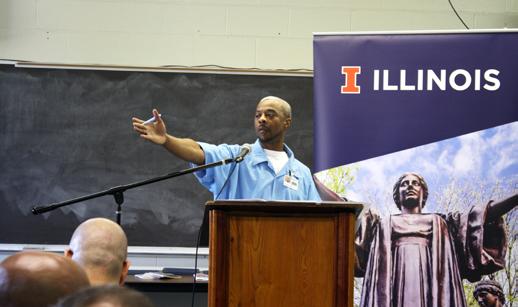
EJP’s work centers on research-based practices, leveraging data to establish guidelines and measure the success of their own initiatives and other HEP programs. As enrollment and initiatives continue to grow, so does support for EJP. Dozens of U of I faculty, graduate students, staff, and community members serve as instructors, policy developers, tutors, and much more. They also host an extensive team of interns who – in addition to research and other projects – read and respond to letters from prisoners and from their families looking for post-release help.
“It’s not just about us providing education to incarcerated people,” explained Ginsburg, “it is also about us learning more and thinking critically about incarceration policies and the challenges of reentry and the criminal justice system more generally.”
As faculty in the Department of Landscape Architecture, Ginsburg finds clear connections between the field and her work with prisons.

“It’s, unfortunately, painfully obvious how working within and learning about prisons and the experiences of incarcerated people contributes to my understanding of sites of repression and exploitation,” said Ginsburg. “Like all professionals, landscape architects and architects need to make decisions about their practice and the values that will guide it. No matter how students on campus feel about this, it’s essential to introduce them to the idea that their work is political and they have agency in how they conduct themselves in the field.”
Ginsburg’s work has brought her to some impressive tables, including her 2016 trip to the White House to speak on prison reform and her recent work with the Illinois Higher Education in Prison Task Force recommending new legislation to Governor Pritzker to improve higher education opportunities for incarcerated and previously incarcerated people.
In May 2023, Illinois Humanities recognized Ginsburg with a Public Humanities Award, honoring leaders who “exemplify the humanities in action across the state.” In her acceptance speech, Ginsburg acknowledged the University of Illinois as a unique environment that fosters the development and growth of programs like EJP. She also invited program alumni to join her for the ceremony in Chicago.
“It was immensely powerful for them to see that the larger philanthropic and progressive community in Illinois considers the education of incarcerated people to be important,” Ginsburg shared. “While incarcerated, they had no way of knowing that the apparatus that supports and sustains a program like EJP is wide and deep. Seeing their affirmation and delight was the biggest honor when receiving the award.”
Rebecca Ginsburg is an associate professor with the Departments of Landscape Architecture; Architecture; Education Policy, Organization, and Leadership; African American Studies; and the Center for African Studies at the University of Illinois UrbanaChampaign. To learn more about the Education Justice Project, visit educationjustice.net .

The City Through The B0dy
BY MARIANA SEDA
What do urban planners and dance choreographers have in common?

At a basic level, both fields center bodies and their relationship to space. For Dance Professor Jennifer Monson and Urban Planning Professor Magdalena Novoa, these disciplines are deeply interconnected by their efforts to address social justice through collective experiments. Monson and Novoa co-created a graduate-level course called “The City Through the Body,” a collaborative attempt to examine and challenge inequities in the urban context by integrating theoretical and practical approaches from both choreography and planning.
Cross-listed in both departments, the course attracted a diverse group of students with backgrounds spanning theatre, dance, planning, environmental sciences, and library sciences – a blend of perspectives that played a key role in the progression and outcomes of the class. With flexibility in mind, Novoa and Monson established a weekly structure which started with student-led conversations about the readings and evolved into movement exercises exploring how to embody those ideas. Students contributed with their own exercises and excursions, like a group visit to the zines library followed by a zines creation session.
“Our main goal was to create a collective practice,” explained Novoa. “We both do this separately in our research and practice, and we wanted to create that experience in the classroom.”
They also wanted to challenge the hierarchies typical in their fields and in academia. Syllabus readings consisted of feminist, queer, and ethical perspectives focusing on social justice and aesthetics. The professors took a seat alongside students as learners, asking questions and inviting students to experiment with the intersections of urban planning and dance, as well as build new methodologies for research and creative practice.
“We created a space where people who may not think of themselves as dancers could move through a space,” shared Monson. “One student described how her experience of being in a dance class helped her address her own positionality, power, and relationship of hierarchical roles through the body.”
Students created immersive final projects that served to disrupt and rethink spaces, resignify land discourses, and create community through engagement and collective practice. One student created a “Sidewalk Ballet” in downtown Urbana featuring classmates enacting public behaviors (think: walking, sweeping, or cycling) with a choreographed rhythm. As part of the performance, a voice narrated an excerpt from a seminal book about cities by Jane Jacobs. Other students created maps with instructions on how to move from place to place; redesigned entire city blocks; and reclaimed underappreciated public spaces like library staircases with music and movement.
According to Novoa, aspiring urban planners – as well as architects and landscape architects – need to understand how to implement these new methods into their future work practices.
“Bodies are the most important elements that make a city,” explained Novoa. “So thinking choreographically is necessary as you think about the living vital systems of cities. In planning we normally draw maps without people in them – just streets and infrastructure. For this course, we really focused on how this infrastructure is actually used and occupied by bodies.”
In a broader sense, students acquired the expertise to apply these principles in their chosen fields. They developed the ability to articulate the possibilities, values, and ethical considerations specific to choreographic and arts-based methods to foster social and environmental change. The course emphasized reflective practices and the importance of cultivating cultural competencies

to collaborate effectively with diverse communities.
“These collective arts-based practices really call on people to listen,” shared Monson. “They open us up to collaboration and encourage new ways of thinking, which is really central to what we all do. It is the most successful way I’ve ever integrated theory with embodied practice before. And our students were really excited.”
A still of the “Sidewalk Ballet,” a dance film activating the choreographies of life in the city inspired by the writing of Jane Jacobs. Watch the film at go.illinois.edu/sidewalk-ballet
PhD Student Receives Inclusion Award for Spatial and Social Justice Work


 BY AMY KARAGIANNAKIS
BY AMY KARAGIANNAKIS
Ana Valderrama (MLA ’09) and her collaborators at Matéricos Periféricos received the 2022 Inclusion Award from the New York City Architecture Biennial. Their project Industrial District includes a series of practices and two buildings co-constructed with the communities in which they serve. The Inclusion Award (iN) was established by the NYC Architecture Biennial to celebrate architecture, interior design, and urban design professionals whose work promotes innovative sustainable design while supporting gender and racial equality around the world.
Valderrama is a PhD student in the Department of Landscape Architecture and the founding director of Matéricos Periféricos, a civil organization for spatial and social justice based in Rosario, Argentina. She currently serves as professor and head of the Master of Landscape Architecture Program at the Universidad Nacional del Rosario (UNR) in Argentina. Valderrama has extensive experience in public and community-based architecture, landscape architecture, and urban
planning. Her doctoral dissertation explores correlations between decolonial bodyartefact assemblages and sociopolitical dynamics in the peripheries of Latin American cities. Valderrama shared, “I expect to offer a critical history constructed from observing body-artefact assemblages as samplings that catalyze different kinds of resistances, dissidences, and insurgencies to the colonial-modernity project.”
Founded in 2001, Matéricos Periféricos is made up of architects and students and focuses on contributing spatial equity in Latin American cities through participatory and socio-community managed architecture. Valderrama and her collaborators at Matéricos Periféricos have accumulated more than 40 awards for their work over the past twenty years including honorable mention from SCA-CPAU for the book Poéticas Colectivas; the Graham Foundation Grant for the book Design-Build Studios in Latin America: Teaching through a Social Agenda; and the XII BIAU Prize for “Inhabiting the margins.”
 Community members, faculty, and students work together to build the Quadoqté Cultural Center in Los Pumitas Neighborhood of Rosario, Argentina.
Gathered at the IMC zine library, the students worked on making their own zines addressing personal ethics, values, and positionalities.
The City Through the Body class members during their final projects public showcase.
Community members, faculty, and students work together to build the Quadoqté Cultural Center in Los Pumitas Neighborhood of Rosario, Argentina.
Gathered at the IMC zine library, the students worked on making their own zines addressing personal ethics, values, and positionalities.
The City Through the Body class members during their final projects public showcase.
7
The class mapped collective points of view on the relationship between the city and the body.
Paying the Gift of Education Forward
BY AMY KARAGIANNAKIS
Over the course of Kendall Hardin’s career, she has gone by the title of designer, chief marketing officer, consultant, principal of her own company, fundraiser, and many others. Each role, while different, had one common theme – the arts. Kendall knows first-hand what it’s like to struggle to pay for that education.

It was the summer of 1966, and after applying for several scholarships that didn’t materialize, Kendall began to worry that she wouldn’t be able to cover tuition for the upcoming semester. Just as she began to accept that she would have to drop out of the University of Illinois before her sophomore year, she received a large envelope in the mail from the School of Art and Design. She had been awarded the Lydia E. Parker Bates Scholarship in Fine Arts which covered her tuition, books, room and board,
and even a small stipend for personal expenses. Kendall recalled, “I was ecstatic with joy. I literally danced around the house clutching that packet.” Lydia Bates, widow of a former dean of architecture, established the scholarship to support female students majoring in architecture, art history, or industrial design based on financial need.
Kendall Hardin regrets never having the opportunity to meet Lydia Bates, adding, “To this day, I think of her as an angel who spurred the trajectory of my life at just the right moment.” Having earned success in her own career as a direct result of this gift from a total stranger over 50 years ago, Kendall wanted to pay that forward. She recently made a generous major gift to the Lydia E. Parker Bates Scholarship in Fine Arts to help other talented women in need of financial assistance seeking
to attend the College of Fine and Applied Arts. This inspiring gift ensures that Lydia’s legacy continues in perpetuity while making a lasting impact in the lives of young women for generations to come.
Passionate alumni and donors like Kendall Hardin make it possible for the College of Fine and Applied Arts to attract and retain the most talented artists, designers, architects, planners, and performers. If you would like to learn more about how you can support the Lydia E. Parker Bates Scholarship in Fine Arts or would like to establish a scholarship in your name, please contact Senior Director of Advancement Brenda Nardi at bnardi@illinois.edu
FGM Architects Establishes Scholarship to Support Students in Perpetuity
BY AMY KARAGIANNAKIS
The Illinois School of Architecture recently celebrated the 150th anniversary of its first alumnus and the nation’s first architecture graduate.
As the school continues to build on its unique history and solidify its role in the future of architectural education, attracting and retaining the most talented students remains a top priority. Scholarship support plays a significant role in ensuring that the school is admitting the best and brightest students.
The School of Architecture is incredibly grateful for the recent establishment of the FGM Architects Scholarship Endowment Fund. FGM Architects (FGMA) has been providing scholarship support to graduate students enrolled in the school since 2018, but just recently endowed the fund. Preference for this scholarship is given to
students pursuing a Master of Architecture but can also be given to undergraduate students in their junior and senior years.
This scholarship is unique in that recipients have the opportunity to intern at the firm while enrolled in school. FGM Architect Scholars that take full advantage of this internship opportunity will graduate with hands-on project experience and exposure to the profession in a competitive environment. As they pursue their architectural education, they are supported financially and professionally – an experience that is truly invaluable.
FGMA understands the value of preparing future architects to make an impact in the field. They are investing in Illinois School of Architecture students because some of them go on to work for the firm after graduation. Since 2018, two FGM Architect Scholars have joined the firm as full-time employees. FGM has utilized
this scholarship and internship program as a recruitment tool of sorts to attract and retain Illinois Architecture graduates. As a national firm with eight locations across the country, we asked FGMA leadership, why University of Illinois? FGMA Executive Vice President and alumnus Andrew Jasek, AIA (BSAS ’93, MArch ’95), shared, “We’re thrilled to support and work with the talented students from UIUC. In doing so, we fulfill our mission of building strong communities while contributing to the continued vitality of our profession. We Build Community.”
The FGM Architects Scholarship is awarded annually to a deserving student on the basis of merit at the Annual Architecture Awards ceremony each year. The Illinois School of Architecture is grateful for this continued partnership with FGMA. Together, we can inspire and prepare the next generation of architects to build a more just and equitable future for all.
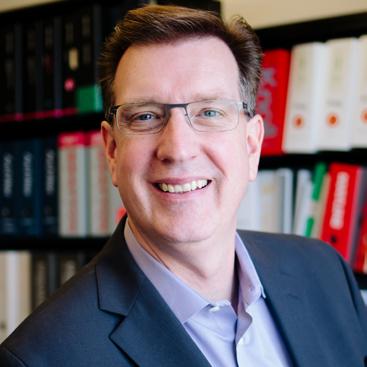
ALINE ROLDAN
(MUP ’18) Planning at Illinois alumna Aline Roldan returned to campus this past spring to present a lecture on the case study of the Homeless Workers Movement in Brazil as part of the 2023 Planning Colloquium series. Roldan, capacity development expert for the United Nations Institute for Training and Research, provided lessons on how community organizers and planners directly engaged with communities can potentially facilitate processes that open up the collective imagination to benefit cities and their inhabitants.
PROJECTS IN PRACTICE
The Department of Landscape Architecture brought three alumni practitioners back to campus for the Projects in Practice lecture series. Kat Katsma (BLA ’11), recipient of the 2017 Bradford Williams Medal for excellence in landscape architecturerelated writing, shared insights about how her experience as writer and editor for Landscape Architecture Magazine proved critical to understanding the diverse landscape profession. Mark Dineen (BLA ’06), associate professor at Colorado State University and co-founder of the experimental art and design studio Zero-Craft Corp, spoke about his land art work “Big Print” (2018). Jason Bernagros (MLA ’09) discussed the Environmental Protection Agency’s Campus Rainworks Challenge and how it relates to green infrastructure technical assistance that the EPA provides to communities.
GERMANE BARNES
(BSAS ’09) The Illinois School of Architecture invited Chicago native and awardwinning alumnus Germane Barnes to speak as the 2022 César Pelli Distinguished Lecturer. Barnes, associate professor and director of the Community Housing Identity Lab at the University of Miami, investigates the connection between architecture and identity, examining architecture’s social and political agency through historical research and design speculation. Mining architecture’s social and political agency, he examines how the built environment influences Black domesticity.
WALTER KENNEDY
(MFA ’99 Dance) Twice a year, in the fall and spring, the Department of Dance hosts the Flatlands Dance Film Festival. The fall feature film was Bella, a documentary about the life, influence, and impact of California-based artist and activist Bella Lewitzky. Illinois Dance alumnus Walter Kennedy came back to campus as a guest speaker for the fall 2022 event. Kennedy was trained by Bella Lewitzky to be one of her master teachers of technique, improvisation, and composition, and was also appointed the company’s rehearsal director from 1990 until the company’s farewell performance in 1997. He is currently an associate professor of dance at the University of Oregon.
SARAH KANOUSE
(MFA ’04 Painting) Part storytelling, part lecture, and part live documentary film, Sarah Kanouse’s solo live performance of “My Electric Genealogy” at the Art and Design Building explored the shifting cultures and politics of energy in Los Angeles through the lens of her own
family. Kanouse is a Bostonbased interdisciplinary artist, writer, and filmmaker whose solo and collaborative work has been presented at the Haus der Kulturen der Welt, Documenta 13, the Museum of Contemporary Art-Chicago, The Cooper Union, the Smart Museum, and numerous film festivals, academic institutions, and artist-run spaces nationwide.
TYRONE PHILLIPS
(BFA ’12 Acting) Illinois Theatre alumnus Tyrone Phillips returned to Krannert Center to direct The Royale. The story followed Jay “The Sport” Jackson, a fictionalized version of the real American boxer Jack Johnson, who became the first Black American to hold the Heavyweight Champion of the World title in the early 1900s. Phillips, artistic director of Chicago-based theatre company Definition Theatre, was excited to share the story and legacy of Jack Johnson. “I am excited because I feel like the play itself is an act of antiracism, simply by shedding light on this story,” said Phillips in February before the production debuted. Watch the full interview at go.illinois. edu/Tyrone
NOËL WAN
(BMUS ’14, AMUSD ’20) Taiwanese American harpist Noël Wan returned to campus this past summer to serve as a guest artist for the School of Music’s Illinois Summer Youth Music (ISYM) Harp Class. An acclaimed harpist and soloist, Wan has performed across North America, Europe, and Asia and has been featured at Carnegie Hall, het Muziekgebouw, Eslite Hall, and the Yellow Barn Summer Festival. Wan is currently an assistant professor of harp and entrepreneurship at the Florida State University College of Music.
We are so grateful to the many FAA alumni that returned to campus this past year to donate their time and talent in various ways.
9
LIGHTS, CAMERA, CONSENT:
HOW ALUMNA JESSICA STEINROCK IS REWRITING THE RULES FOR INTIMACY ONSCREEN AND ONSTAGE
 BY MARIANA SEDA
BY MARIANA SEDA
How do you go viral on TikTok? Try educating the public about how Hollywood films sex scenes while using your research to revolutionize the entertainment industry. That’s essentially how alumna Jessica Steinrock (MFA ’17, PhD ’20) has reached nearly 40 million likes on the popular video platform.

Steinrock, who was recently featured on the front page of The New York Times, has gotten a lot of publicity for her pioneering work in intimacy coordination and direction, a relatively new field that aims to build consentbased practices around intimate moments (anything from dancing to kisses to simulated sex) onscreen and onstage.
An intimacy coordinator, like a fight choreographer, puts safety and believability at the center of their work. They serve as an advocate and liaison for actors who are asked to perform nudity, sex simulation, or other actions that could put someone in a vulnerable position. Directors also collaborate with intimacy coordinators to choreograph intimate scenes to help make the relationships look real and tell the story effectively.
“For so long, filming of intimate scenes has been shrouded in so much mystery,” explains Steinrock. “Actors are often not taught what to expect. Consent needs to be informed. And an actor requires time to consider whether the things being asked of them are things that they want to do.”
During her time at the U of I Department of Theatre, Steinrock researched intimacy direction as a new field of practice and professionalism, but also as
a “model for other disciplines to redefine their relationship to power, inclusion, and sustainability,” as she writes in her dissertation. As CEO of Intimacy Directors and Coordinators (IDC), Steinrock continues to translate her doctoral research into real world practice through education, training certifications, and professional experiences.
“Our company really focuses on education,” explains Steinrock. “IDC’s mission is to equip every institution and individual artist in the entertainment industry with the resources and education needed to create a culture of consent in which intimate stories can be told with safety and artistry.”
So how does an industry approach a “culture of consent” today? According to Steinrock, this requires training intimacy professionals to be both choreographers and educators when they enter spaces. It also calls for integrating consent practices into every stage of a profession, including higher education and training institutions.
Even as work environments for theatre, film, and television evolve into more consent-based cultures, there remains a disconnect between higher education and professional settings.
“We are still, especially in education spaces, prioritizing a guru mentality,” Steinrock clarifies. “There’s a lot of ‘you have to be the director’s vision;’ you are there to be molded by an instructor. And that’s, historically, what acting training has been. The problem with this is that you lack autonomy.”
In her teaching, Steinrock has noticed that incoming college students arrive with an understanding of the #MeToo movement and its implications and far more awareness of issues like boundaries, identity, oppression, and consent.
“They pick it up really quickly,” says Steinrock, “but it’s also creating some clashing between the way things have been and the way things are going.”
In recent years, much of the work in higher education and conservatory spaces has been about bridging the gap between the knowledge and experience that faculty bring with the rapid expansion of consent-based practices in theatre making.
“This is not only necessary for ensuring respect and autonomy for individuals,” says Steinrock, “it’s important for the benefit of a student’s professional career. This is where the industry is going. So, if a program wants to pride itself in being a professional training program, this is now a part of that profession.”
The recent boom in visibility for intimacy professionals has been in part due to Steinrock’s popular TikTok channel that “breaks down the spicy scenes in TV and film.”
Using comedic acumen (from years of improv training) and a shame-free approach to people’s curiosity, Steinrock explains how intimate scenes were likely choreographed and filmed to look very real but are actually done safely through careful negotiation,
clear communication, and consent. She also spends time diving into the wider conversation about consent, responding to current events and advocating for more openness about the once taboo topic.
“I want to see more directors being consent advocates. I want to see more fight directors being consent advocates. I don’t think that it just needs to be intimacy people,” shares Steinrock. “My hope is that a director can be like, ‘oh, I can stage a slap. I can stage a kiss.’ But if we’re going to have a lot of nudity or going to have simulation, then they know to hire an intimacy professional.”
Why don’t we see many actual examples of intimacy choreography in her videos?
“There’s literally a guideline against sex simulation on TikTok. So I have to be really careful. Even in one of my videos where I’m talking about Queen Charlotte, I’m just demonstrating a little, and they were like ‘nope’ and took it down.”
PLAYING OUR PART
BY LATRELLE BRIGHT AND THOM MILLER
Shapeshifting. That’s how the recent news described the U.S. American Theatre landscape. The field of theatre is attempting to remake itself for the purposes of sustainability, relevance, and economics; and the programming and season subscription models seem to be at the center of this shift. Diverse programming efforts, or a broadening of the Western canon with new work from marginalized voices, is not new news.
Responding to these efforts in the academic setting is new; so, three years ago, two things happened.
First, the core Theatre Studies faculty began a conversation about who we were as a program, what our gifts were as educators, and how best to prepare our students for this moment in U.S. American theatre. Already in place were courses in dramaturgy, playwrighting, and directing; however, the courses were not in concert with one another. A student could specialize in one area without knowing how it worked with or complemented the others in any formal way. Listening to the shifting shapes and the interests and expertise of faculty, we saw a clear and direct way to shape not only the department but student experiences to ready them for the evolving world of theatre. This evolution is a place that nurtures the relationship between playwrights, dramaturgs, and directors, in the development of new plays from those new voices.
Second, Gabriel Solis, the former head of Illinois Theatre, initiated a program to elevate the Theatre Studies program and the contributions of its students with a permanent place in the official Illinois Theatre season. We have developed a series called the Theatre Studies New Works Project, that is produced biennially where 2–3 new plays by students are workshopped with student dramaturgs and directors and
presented in a festival format in the season. These works range from full-length plays that have gone through numerous drafts that are semi-staged and lightly designed; first drafts of plays ready for a traditional public reading; and devised pieces that are created from scratch with an ensemble.
From these efforts and with the strong support of Theatre Head Valleri Robinson, a new course titled New Play Development is now offered to ready students for a robust and respectful creative process. In addition to learning the long history of new play development and the economics of producing new works, students learn the varied ways each role (director, playwright, and dramaturg,) can support the process. We invite writers into the classroom to respond to their work, in whatever stage of development, gaining hands-on experience being in conversation with other artists. Making art is a vulnerable act, and these conversations are not always easy, so a safe, respectful space is essential. As we engage more and more with stories about people from the margins, we must be sensitive, brave, open, and forthright, and above all, humble. Wanting more stories about diverse peoples is not enough. We must make the effort to create and nurture those artists so they can do their work. This course, this program, is about that work.
All of this is particularly important to expanding the Western canon
and diversifying our stages. Right now, we are reaping the benefits of a plethora of playwrights from the margins graduating from MFA programs, becoming resident playwrights at theatres of all sizes, and receiving grants and other funding to support their work and livelihoods. Our students are helping to lead this undertaking.
Recent graduate Jordan Ratliff (BFA ’21 Theatre Studies) directed the Chicago premier of Donja R. Love’s One in Two at Pride Arts Chicago. Melody Contreras (BFA ’21 Theatre Studies) served as dramaturg for Remy Bumppo’s production of Anna in the Tropics by Nilo Cruz. Sophia Urban (BFA ’25 Theatre Studies) and Kashara Bennett (BFA ’23 Theatre Studies) served as assistant directors for Rivendell Theatre Ensemble’s reading of Honey Bee Baby by Erlina Ortiz in late August 2023.
It is an interesting time to be a theatre maker and theatre watcher. Here’s to the shifting and shaping of the new American Theatre landscape, both for those who create it and those who support it, and for all of us who will benefit from doing the work.

11
“Close” by Lucy Laplaca presented during the Theatre Studies New Works Project produced by Latrelle Bright, and directed by Sophia Urban, spring 2023. Photo by Darrell Hoemann.
BY AMY KARAGIANNAKIS
Q&A WITH MARC DOUSSARD
Marc Doussard started as the new head of the Department of Urban and Regional Planning in August 2023. As a professor of urban and regional development, he focuses on equitable economic development at the community, city, and regional levels. His research examines the economic value of social practices, policy development, and emergent issues typically considered to lie outside economic development. Marc holds a bachelor’s from Columbia College and a master’s degree and PhD in Urban Planning and Policy from the University of Illinois Chicago. He has been active in economic development as a scholar, program staffer, public intellectual, and organizer since the 1990s. We sat down with Marc to talk about his new role as department head.

It has been over 10 years since you joined the faculty at the University of Illinois Champaign-Urbana. What was it about the Planning at Illinois program that inspired you to pursue a teaching position here?
Most planning departments operate as federations of sorts, platforms for people to do their thing individually. From the first time I visited, It was clear that Illinois is different, more focused on the collective and on creating a substantive experience for students. There’s an energy to it, and people want to be part of energizing things.
You have had the unique opportunity to watch this program change and grow over the last decade. What aspects of this change are you most proud of or feel that you played a significant role in?
Planning is in many ways a mirror to society – we focus on new, emergent challenges for which there’s no playbook because they haven’t happened before. We live in extremely interesting times, and our department has handled the change better than most. We have a bunch of creative, ambitious people who are more comfortable trying on new things and looking forward than trying to update our past ideas about how the world works. I’m especially excited about the three new faculty we’ve hired to work on sustainability and inequality. The things they do research on – Chinese eco-cities, the creation of ‘nature’ in ways that privilege developers,
and community aqueducts – are important in their own right but also really creative things to study. I’m extremely optimistic about the new paths we’ll be able to open up for students.
As the new department head of a growing program and student body, what are your top priorities over the next three years?
I want the department to take care of the basics in a way that lets everybody thrive. We have so many good people who’ve tapped themselves out to keep things going at a high level through the pandemic. The recipe for success is pretty simple: Take care of the basics so people can do their thing and thrive.
Your book Justice at Work with coauthor Greg Schrock examines how the economic and social justice movements of the 2010s brought about long-overdue urban policy change across the country. You have spoken about the power of grassroots organizing and how these movements have the potential to bring about more inclusive economic development in our cities. How are you incorporating this into your teaching and inspiring the next generation of planners to be part of this change?
Thank you so much for asking this. The book comes up in teaching all the time because it’s optimistic. When I started graduate school, faculty kind of delighted in hazing us, asking us to propose good and equitable ideas, then explaining how they all went sideways in practice. Justice at Work is a book of pragmatic, grounded hope, a vision for building an economy that meets our expectations by making sure everyday people have the stability and opportunities they need to thrive.
The Department of Urban and Regional Planning hired three new faculty members this year that will contribute research and teaching in the areas of environmental design, climate change and disaster management, and urban political ecology. Can you talk about the significance of these areas and how these new faculty members will play a part in strengthening the planning curriculum at Illinois?
Ecology and sustainability are holistic frameworks for organizing the way we think about the world. Focusing on them means we look at all kinds of hidden forms of power, opportunities, and challenges. With our new faculty, we’ll have a broad array of classes on the environment. What’s especially exciting is how nuanced and specific those classes will be. Everyone we hired has a background in design and the natural sciences, and they harness that experience to ask deeper, more sophisticated questions. I’ll add that they’re all dynamic speakers – people who are so in command of the material that they think fast on their feet without breaking a sweat. It’s great news for our students.
BY JENNIFER GUNJI-BALLSRUD
In 2015, Japan House decided to share Japanese arts and culture on a larger scale by orchestrating Matsuri, which is the Japanese word for festival. Knowing that there were many summer matsuri that took place in the Chicagoland area, at Anderson Japanese Gardens, and at the Missouri Botanical Gardens, it only seemed appropriate to hold such a festival on the grounds surrounding Japan House. The idea evolved to support like-minded businesses, artists, martial arts organizations, performance groups, student organizations, and musicians who would want to celebrate Asian culture together. We shared the event on social media and hoped to host around 1,000 visitors. It was an overwhelming success with an estimate of over 3,000 participants in the festival that first year.

Since that time, Japan House has strived to continue the tradition of sharing Asian arts and culture at Matsuri through food, libations, performances, crafts, arts, and so much more. The festival is only possible through the generous support of our donors and the tireless hours that hundreds of volunteers share with Japan House. This past May was the first Matsuri after a 3-year hiatus during the pandemic. We welcomed Japanese artists Niwa Zenkyu and Seiran Chiba who not only participated in the festival but also shared their art with local schools and organizations. Many other artists also participated, sharing their work and products with hundreds of visitors. Local food vendors showcased Asian flavors with dishes that delighted the crowds. The stages, filled with dancing,
music, and martial arts demonstrations, closed out the evening with fireworks and an encore performance by the allfemale rock band from Japan, The 5.6.7.8’s.
Matsuri is an opportunity for Japan House to share their appreciation with the community by providing a family-friendly event that exposes individuals to the tastes, cultural practices, sounds, distinct differences, and wonderful similarities of the broader Asian community. Aligning with Asian American and Pacific Islander Heritage Month, Japan House was honored to be able to showcase, recognize, and share the artistic and cultural practices of so many cultures in one day.

13
50 YEARS OF ARCHITECTURE ABROAD

The La Napoule experience was a major influence on my final career choice. After getting licensed in Illinois as an architect in 1972, I received a teaching appointment at Cal Poly, San Luis Obispo, CA, where I retired in 2007 as an emeritus professor of architecture. The appreciation I gained for high-density, mixed-use living in villages on the Cote de Azure (which Professor George Ramsey had us thoroughly document), as well as reading Jane Jacobs’s seminal book in an urban sociology class, helped me teach my students in design studio for over 32 years. Their studio projects, and later many of their built projects in practice on the California central coast and beyond, have all been a result of that French experience.
The Illinois School of Architecture’s flagship study abroad program has a rich history that spans over 50 years and four generations. The program began at La Napoule, moved to Versailles, and is currently in Barcelona. The program provides a unique opportunity to live and study in an architecturally vibrant overseas environment while making life-long friends and memories.
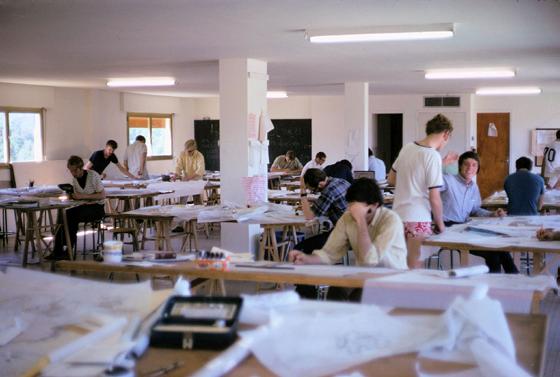
Check out more Architecture Abroad experiences at go.illinois.edu/arch-abroad.

 Patrick Hill (BA rch ’70, MS ’72) LA NAPOULE
La Napoule, Place de La Fontaine. Photo by Patrick Hill.
Studio on the top floor with Patrick’s desk in the foreground.
Patrick Hill (BA rch ’70, MS ’72) LA NAPOULE
La Napoule, Place de La Fontaine. Photo by Patrick Hill.
Studio on the top floor with Patrick’s desk in the foreground.
Eric Rowland (MA rch ’90) VERSAILLES
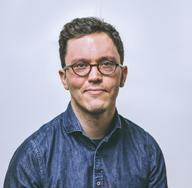


During our April break at the Versailles program, we bareboat chartered a sailboat from Athens to explore the Greek islands. The weather started out cool and rainy, and a squall caused us to anchor below the temple of Poseidon. The constant cold winds and waves required us to post watch all night to be sure we didn’t lose our anchor. The weather slowly improved as we explored the islands, and we finally returned to the same harbor where the Temple was illuminated for the filming of a music video. The experience led to me being the site architect of the Kavousi excavation on Crete during my last summer at Illinois.

Emily Posey (BSAS ’20) BARCELONA

My year abroad in Barcelona was impactful in so many ways – I not only grew in my knowledge of the built environment but also as a person in general. I learned how to see architecture through the lens of different cultures; how to sketch and capture ideas in the moment; how to balance work and play; and most importantly, how to build relationships with people from diverse backgrounds.
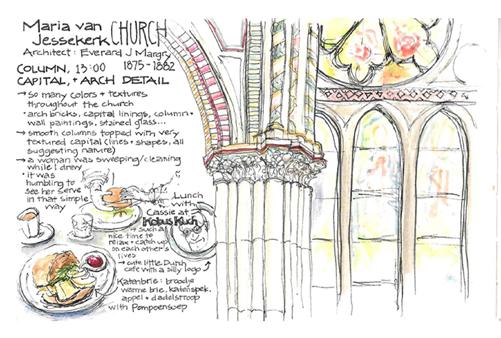
Max Bemberg (BSAS ’09) VERSAILLES
My study abroad experience in Versailles, France, was an immersive journey that left an indelible mark on my passion for architecture, ultimately motivating me to establish my own architecture firm. The inspiration began with the guidance of my talented professors, whose expertise and dedication fueled my creative drive. We were taught to be critical thinkers and to analyze and learn from our surroundings. We were also encouraged to explore and have fun. One of the unique aspects of my study abroad program was the eccentric and stimulating studio culture – surrounded by students from around the world with diverse backgrounds and perspectives. It was within this dynamic atmosphere that I realized my desire to create a firm that would embody this spirit of exploration and collaboration.
Eric Rowland and fellow Versailles study abroad students chartered a sailboat from Athens to explore the Greek Islands.
Morning walk in Spain. 15
Sketches from Emily Posey’s travel journal while studying abroad in Barcelona.
Q&A with Lamont Holden
BY MARIANA SEDA
Lamont Holden, clinical assistant professor of audio and recording technologies, is making waves in the music education scene. By partnering with working artists in the music industry, building out cultural projects, and creating spaces for students to amplify their voices, Holden is ensuring that the next generation of music professionals will enter the industry with confidence, creativity, and a strong foundation for success.
Your recent work seems to center on giving students a chance to actively participate in creation as they’re learning how to do a variety of different technical and artistic skills. What is your mission when it comes to teaching music and audio recording and technology?
LH: My mission is to get them to do and get better by doing. Unlike a lot of other folks, I taught myself all the music and audio skills that I know. I was in Atlanta for four years and most of that time was spent learning the music industry. But my formal training is as a public middle school teacher for inner city schools. Unfortunately, you get students that haven’t had a chance to learn basic skills because they’re in schools where there’s a revolving door of teachers – people don’t care to give them one-on-one attention. One of the things I got good at as I became a teacher was teaching myself well. I approach higher academia in a similar way by meeting students where they are. All learners are capable, they’ve just got different levels of experience. So I’m going to challenge students individually based on their needs.
Tell us a little bit about the work you’ve done with visiting artists and how that role is evolving both in the classroom and beyond.
LH: Students need to hear and see from experts that do this work. What I love about music education here at Illinois is it’s not just about music. It is truly about education. Dr. Adam Kruse, another music educator here, empowered me to teach not as a centered expert. I’m a facilitator of learning. I teach in three phases, generally speaking: I do. We do. You do. So I’m going to teach and show you how to do it. Then we’re going to do it together. Then you’re going to do it. Coteaching with an expert helps the “we do it” part, and it serves as an exemplar so students can see this work scaled at many levels.
On top of that, when you go to the University of Illinois to study music and audio recording technology, you’re truly connected to the industry. Because it’s not just the learning that you get, you also get the network. So when it’s time for students to graduate, and they want to move to Atlanta or L.A. or New York and get experience, they’ve got people to reach out to.
Can you elaborate on your collaboration with DJ Burn One and the course you cotaught, Music Monetization 499?


LH: I first met DJ Burn One when I interviewed him for a podcast I used to host, Producergrind Podcast. He’s working with Yelawolf, A$AP Rocky, Nicki Minaj, Don Tolliver. He did Gucci Mane’s first five mix tapes. He’s just a guy who is connected and accessible if you have the budget. So I told the school that we need a course that teaches people how to get into the music industry, and we need that course to be taught by somebody who’s in the music industry. Instead of going the adjunct faculty route, we purchased the course he already offers and molded it into our music monetization course. We did it in spring 2022 and supplemented the classes with live music review shows on Instagram as well as individual time for students to meet with DJ Burn One. It all culminated with him coming to campus for a visit and an interview on our Campus Culture Digital podcast. When he was here, he did beat battles, he did the DJ set, and then he just made music with the students.

Can you share more about your work in building community through music, culture, and conversation, specifically through your podcast, Campus Culture Digital?
bLH: Campus Culture Digital is a platform for students and local community members to express their creativity through rap performances and conversations. It’s also an opportunity for artists, producers, and engineers to practice their craft. Originally it was centered around student artists focused more specifically on rap. But we’ve also moved towards more interviews and discussions on issues students are facing in general. If you’re Black and you’re thinking about coming here and you lay your eyes on that, you feel like there’s a space for you. If you’re a student of color, if you are a queer person – after you have a chance to see this, you should feel comfortable and think, “oh, there might be a space for me,” and not just to be tolerated but celebrated

campuscultureIL campusculturedigital
Professor Holden empowers students to make their own music at ISYM Hip Hop Camp.
Legacy Award 2023 Recipients
Distinguished Legacy Award
David Bilger (BMUS ’83)

Distinguished Legacy Award
Douglas Busch (BFA ’74 Graphic Design)
Distinguished Legacy Award
Coleen Sterritt (BFA ’76 Sculpture)

For a full list of alumni awards and achievements, visit go.illinois.edu/FAA23Awards.



Distinguished Legacy Award
Scott Curtis Wilson (BSAS ’74, MArch ’76)

Emerging Legacy Award
Mariam Thiam (BFA ’04 Dance)
Illinois Arts Legacy Award

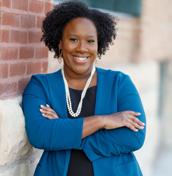

Kimiko Gunji (MS ’71 Library Sciences, MA ’79 Asian Studies)

17
Moon Ark
Illinois alumni create a tiny museum bound for the moon
 BY TRACY CRANE AND AMY KARAGIANNAKIS
BY TRACY CRANE AND AMY KARAGIANNAKIS
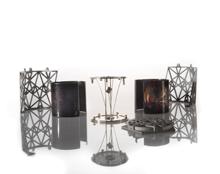
When Astrobotic’s Peregrine lunar lander launches from Cape Canaveral on its way to the moon, the payload will include the MoonArk, a 10-ounce time capsule that was designed by Illinois alumni to last on the surface of the moon for thousands of years.
At only eight inches high and two inches in diameter, the metal MoonArk sculpture has four stacked chambers packed with hundreds of images, poems, music, mechanisms, earthly samples, and nano-objects, including gold nano-sized rods fabricated in the Murphy Lab at the University of Illinois.
The MoonArk project has been led by a team of Carnegie Mellon University (CMU) faculty members that include FAA alums Mark Baskinger (MFA ’01 Industrial Design) and Matt Zywica (BFA ’02 Industrial Design), as well as another FAA alum Mark Rooker (BFA ’92 Graphic Design, MFA ’99 Metals, MFA ’00 Graphic Design) who is a faculty member at James Madison University.

Baskinger has worked as director on the project for more than 10 years along with fellow CMU faculty and students and a host of international collaborators, involving more than 20 international companies and universities, and 60 team members.
Baskinger said, the sum of their “work embodied in 10 ounces of material represents an immense effort from distributed teams, individual artists and designers, students, scholars, researchers, scientists, technologists, explorers, curators, photographers, educators, musicians, and interesting people doing really interesting things.”
After successfully passing space-readiness vibration, electrical, thermal, and vacuum testing, the MoonArk has been installed onto the lander deck and will soon be delivered to Cape Canaveral. The Peregrine lunar lander was designed and built by Astrobotic, a Pittsburgh company and Carnegie Mellon University spinoff partnering
with NASA. Peregrine will also be flying payload for NASA and more than a dozen other projects from various groups, including the first lunar rover Iris.
Rooker fabricated most of the metal work inside the MoonArk. Baskinger and Rooker were graduate students together at the University of Illinois School of Art and Design. Baskinger recruited Rooker to the project knowing that they needed a sculptor who could work precisely and skillfully with nano-sized pieces of metal. Rooker, professor and head of the James Madison University (JMU) metals program, jumped at the chance to be part of the MoonArk team. “We have launched thousands of things into space, and without exception, they are
dull, ugly, hyperfunctional things,” Rooker shared in a JMU article. “They speak well of our desire for information and communication, but they do not capture our aspirations or the complexity of our cultures. The MoonArk is an attempt to place a richly detailed snapshot of humanity in a place where we are only beginning to be able to reach.”
A pentagonal structure with four independent but interrelated exoskeletal chambers – Earth, Metasphere, Moon, and Ether – the MoonArk contains elements representing the Arts, Humanities, Sciences, and Technologies. The chambers encompass the most advanced state-of-the-art material and fabrication practices – from the nano- and micro-scales, to the infinite scales including ever ongoing deep space radio-wave transmissions broadcast in 2016 in advance of the MoonArk’s 2023 journey.

“It’s a cutting-edge object in so many ways, like bleeding-edge technology,” FAA alum Matt Zywica shared with CNN. “It involved 3D printing and the machining of wafer-thin sapphire disks that really pushed our capacity.”

Earlier this year, NASA announced the landing site for Peregrine near Ocean of Storms on the western part of the moon’s near side. Peregrine will be powered to the moon by United Launch Alliance’s Vulcan Centaur rocket.
An identical MoonArk, which has traveled the world for display at exhibitions, festivals, and presentations, will remain on earth. In April 2022, the twin MoonArk was accessioned into the permanent collection of the Smithsonian National Air and Space Museum.
19
This intricate part of the Moon Chamber contains moon drawings, moon poems, concentric eclipses, and the moon museum. It is assembled from discs and tiny maquettes created by Mark Rooker. Photo by Dylan Vitone.
FIRST MFA
The Evolution of an Industry Through UIUC’s Graphic Design Alumnus
BY AMY KARAGIANNAKIS
The graphic design industry has evolved greatly over time. While some may claim that the origins of graphic design date back to early cave paintings, the industry as we know it today began roughly around the very beginning of the 19th century. Perhaps the most significant period in the evolution of graphic design took place from the 1960s onward as the industry slowly moved from the Swiss Style to the digital era. Alumnus Barry E. Huber (MFA ’66) had the fortunate lived experience of working in graphic design during this transition.
Huber enrolled in the School of Art and Design’s new graphic design graduate program in 1963. As the counterculture movement began to take off, artists were challenged to push the boundaries of traditional design, manipulating typography to evoke different meaning and feelings. It was through Huber’s thesis that he himself explored how manipulating color, size, and position of type on a page could, in fact, alter the meaning of the text just by changing its visual appearance.
Huber, along with three other classmates, became the inaugural Master of Fine Arts in Graphic Design graduating class in 1966. Ron Sterkle, a graphic design professor, recommended Huber for a summer internship at the Federal Reserve Board (FRB) while he was still attending school. It was through this experience that he was able to later secure a position as an experimental designer with the FRB in Visual Graphics in 1968. During his 30-year tenure with the Board, he was also provided opportunities to work on projects for a colleague involved in the fine arts. While he certainly valued the work he did for the Board, it was these projects that brought him the most pride and joy as a graphic designer. One project was a portfolio he designed for the National Symphony Orchestra Ball sponsored by Australia in 1986. As Huber held and described the individual pieces of this portfolio with such detail and passion, it was very apparent how proud of this work he was. So much of graphic design work is now digital that we often miss out on the tactile elements of the art.

The introduction of Apple’s Macintosh computer in 1984 and the incorporation of PageMaker in 1985 marked the beginning of a new era in graphic design. Huber experienced this transition first-hand and recalled, “I didn’t embrace the change with open arms, but I didn’t fight it either. When we were expected to make the change from the drawing board to desktop publishing, the Fed hired a technician to help with the transition. Just the simple fact that you could print multiples so much easier was enough motivation to welcome the new technology.” Adobe InDesign later replaced PageMaker as the go-to desktop publishing and design software as the field moved from print to web design. It was around this time when Huber retired from the Federal Reserve Board in 1998. He continues to enjoy retirement with his partner of 31 years Olen “Butch” Bradburn.
The graphic design graduate program at the School of Art and Design is now in its 57th year. It was Barry Huber, his fellow classmates, and passionate faculty like Ron Sterkle and A. Doyle Moore that allowed the program to develop and grow into what it is today.

STORY : go.illinois.edu/barry-huber
FULL
Barry Huber (MFA ’66).
ILLINOIS THEATRE ALUMNUS MAKES HIS BROADWAY DEBUT IN HAMILTON
BY AMY KARAGIANNAKIS



Illinois Theatre alumnus and Champaign native Jonathan Butler-Duplessis (BFA ’10 Acting) made his Broadway debut as Hamilton’s iconic Aaron Burr in February 2023. Originally brought on as part of the ensemble, Jonathan was notified just days before joining the cast on stage that he would be debuting as Burr.
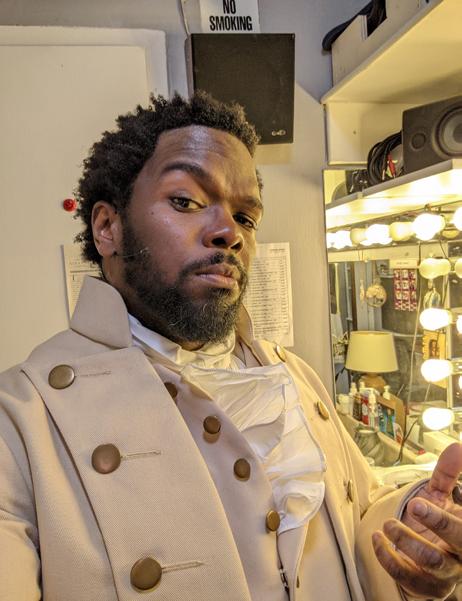
Jonathan is no stranger to the works of Lin-Manuel Miranda – in 2013, he played Benny in Chicago Paramount Theatre’s In the Heights. He was nominated for the Joseph Jefferson Equity Award for Supporting Actor in a Musical in 2017 for two separate Chicago performances: Sebastian in The Little Mermaid and Jim Conley in Parade. He won the Jeff Award for his role as Jim Conley in Parade (Writers Theatre) under the direction of Gary Griffin.
FULL STORY:

go.illinois.edu/FAABroadway
 Recruitment flyer for the newly established Graphic Design graduate program at the University of Illinois (1965).
Recruitment piece for the Federal Reserve Board designed by Barry Huber.
Cover of the program Huber designed for the 1986 National Symphony Orchestra Ball held in Washington, D.C., and sponsored by Australia.
Recruitment flyer for the newly established Graphic Design graduate program at the University of Illinois (1965).
Recruitment piece for the Federal Reserve Board designed by Barry Huber.
Cover of the program Huber designed for the 1986 National Symphony Orchestra Ball held in Washington, D.C., and sponsored by Australia.
21
RESEARCH IN ACTION
BY MARIANA SEDA
Arts Impact Initiative

The Arts Impact Initiative increased efforts this year to expand understanding and support for artists and creative workers in Illinois and beyond. As one of three institutions leading the Strategic National Arts Alumni Project (SNAAP), FAA played a leading role in administering the 2022 SNAAP survey and had more than 5,000 alumni participate. In support of this research, the college hired Dr. Shanita Bigelow, a research fellow whose analysis and interpretation of college alumni data will be used to help guide curriculum and strategic directions.
In addition to SNAAP, the Arts Impact Initiative led FAA in a partnership with Discovery Partners Institute (DPI); the College of Architecture, Design, and the Arts at University of Illinois Chicago; and Arts Alliance Illinois to help shape the future of workforce development for creative workers in Illinois. This partnership will serve as a prototype for how working across the public and private domains can strengthen opportunities for artists and other creative workers.
With support from the Presidential Initiative, a research team led by Professors Jennifer Novak-Leonard, Andrew Greenlee, and Magdalena Novoa published three issue briefs and hosted two panel events focused on the lives and livelihoods of creative workers in Illinois and nationwide. Addressing key issues like housing affordability and its intersection with race, ethnicity, and gender, the research aims to inform practice and policy at the city, state, and national levels, further supporting arts graduates.
Explore the research and learn more at artsimpact.faa.illinois.edu
Crip*—Cripistemology and the Arts
Crip*—Cripistemology and the Arts is a transdisciplinary initiative housed in FAA and co-founded by Christopher Robert Jones and Liza Sylvestre, both research assistant professors with FAA. Crip* is a practicebased, experimental collaboration that draws points of connection between artistic practice and critical thought.
In spring 2023, Crip* hosted a series of hybrid and accessible events highlighting the work of guest artists and scholars currently engaging in conversations and artmaking around Crip/Disabled experiences. Artist Carmen Papalia visited campus to give a public lecture and to perform Blind Field Shuttle, an interactive non-visual walking tour in community with attending students, staff, and faculty. Dustin Gibson and Talila “TL” Lewis presented a conversation sharing thoughts on disability justice, addressing the ableism central to policing and prison systems, and offering interventions. Crip* also hosted Dr. Sarah Hayden and audio describer Elaine Lillian Joseph through their project slow emergency siren, ongoing which explores how identity and subjective experience complicates and enriches access of culturally engaged, historical events and social/political movements.
In addition to their hybrid and accessible lecture series, Crip* created an undergraduate internship program for Crip/ Disabled identifying students and offered a variety of undergraduate and graduate courses that engaged students in forming a cripistemelogical perspective as well as the support to incorporate that perspective into creative/critical practices, shaping the way students approach their respective mediums.
Learn more at crip.faa.illinois.edu
Minor Aesthetics Lab
The Minor Aesthetics Lab (MAL) is a multisensory lab for minoritarian aesthetics, experiments, incubations, productions, and creative-theoretical work. It is spearheaded by Dr. Sandra Ruiz , the Sue Divan Associate Professor of Performance Studies in Theatre and English. Housed in FAA, MAL serves as an experiential learning environment, emphasizing rehearsal and experimentation, practice-based cultural methodologies, and the building of emancipatory knowledges.
To kick off the lab, Ruiz led a graduate seminar in which students read and experimented across texts in performance studies, feminist, trans, and queer studies, visual culture, cultural studies, and relational ethnic studies. The seminar’s final symposium highlighted the generative work of students’ research. PhD student Laura Coby, the Sue Divan Graduate Fellow for Spring 2023, coordinated a series of workshops exploring María Irene Fornés’ play Fefu & Her Friends. With Ruiz as producer through MAL, Coby directed a one-night staged reading of the play in collaboration with the Fornés Institute.
MAL also hosted a series of visiting writers, artists, and scholars who explore minor aesthetics in their work such as Alexis Pauline Gumbs, Cassils, Raquel Gutiérrez, Uri McMillan, and Hypatia Vourloumis. MAL collaborated with units across FAA and LAS to host guest performances, workshops, public lectures, and office hours with students interested in learning more about their work and creative processes.
Learn more at malab.faa.illinois.edu
L to R: Mike Davis (Illinois Land Bank Authority), Sarah Marie Dillard (Peoria-based artist and advocate), Dr. Andrew Greenlee, and Dean Kevin Hamilton discuss housing affordability for Illinois artists and creative workers.
Photo by Basmah Kishta (BSAS ‘22, MArch ‘24).
Faculty Explore Black Spaces Through Immersive Art Exhibit
BY MARIANA SEDA
In 2022, Krannert Art Museum hosted the exhibition Black on Black on Black on Black, featuring four faculty members from the School of Art and Design exploring the themes of time, space, identity, music, and memory through the lens of Black Quantum Futures.
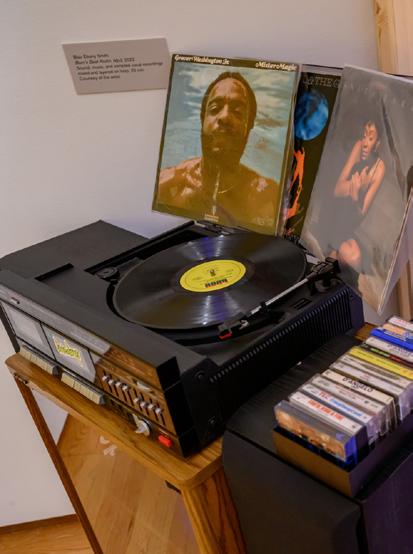

The exhibition showcased the works of Visual Artist and Studio Art Chair Patrick Earl Hammie, Graphic Design Professor Stacey Robinson, Art Education Professor Blair Ebony Smith, and Graphic Design Professor Nekita Thomas. Through striking multimodal and immersive installations, the artists invited museum-goers to witness and sometimes step into spaces designed for and defined by Black lived experiences and realities.
Rooted in the act of placemaking, the installations by Thomas and Smith, in particular, established a powerful and interconnected narrative by exploring identity through the framework of Black women and Black girlhood.
In “Black Space Protocols,” Thomas examined the idea that space is not racially neutral, particularly in institutions like museums and academia. By asking visitors to navigate a space she created using everyday objects like
milk crates, t-shirts, and decorative flowers, Thomas underscored Black spatial practices and the potential for fortification, joy, and liberation through deliberate design.
“I think a big portion of what happened in ‘Black Space Protocols’ for me was thinking about a space for self-care. I was tapping into the strengths of the design sensibilities that my family has – like my mother, my brother, my aunts. It has opened up whole new ways for me to think and play and for my work to have joy,” explained Thomas.
Thomas also challenges the ways space can be organized, owned, and exclusionary. “It’s like allowing yourself to ebb and flow in and out of those conversations, but doing it in a way that feels like it’s leveraging and acknowledging those histories that are very familiar to me but are not always privileged by the university and the scholarly world.”
Thomas considered this installation as an entry point for her to address the practices and habits that support her art-making, including carving out creative space for herself in places like the university, where her work is often centered on research and writing.
23
continued...
Black on Black on Black on Black : School of Art & Design Faculty Exhibition, 2022 Installation view at Krannert Art Museum. Photos by Fred Zwicky , UI Public Affair
23
Featuring, left to right: Art by Blair Ebony Smith; Art by Nekita Thomas; Exhibiting artist Nekita Thomas speaks at the opening celebration.
“My studio practice does not always fall within the realm of research, but it’s something that sustains my health,” said Thomas. “Oftentimes when you’re on the tenure track and you’re writing research papers, some of that self-care gets lost. So that’s what I used this time and installation to think about: What are those protocols that are currently coming up in my work that don’t just support me as a scholar, but also support me as a Black woman?”
Smith comes from a Black critical arts education background and is deeply informed by her sound work as a DJ, lovenloops. As a postdoctoral researcher with Krannert Art Museum, Smith first started working in public engagement curation, focused on Black girlhood celebration with Black girls as a studio art practice, and learning the processes behind putting together an exhibit with related programming.
“It’s great to have colleagues help me into the space and figure out what’s needed, what the conversation has been, and to think more deeply about the history of Black artists, professors, staff, students, and folks that come through and have come through the School of Art and Design,” noted Smith. “It was very special to lean on the experience of Nekita, Stacey, and Patrick, who have been doing installations and public artwork for years, and to bring my experience and do my own thing too.”
Smith’s installation, “(Refrain) Turn Me On – Would You Come On Home?” wove together sound and photographs, creating a poignant remembrance of family. Drawing from her father’s mix tapes of jazz, funk, hip-hop, and soul, Smith constructed a soundscape that resonated throughout the exhibition, holding conversation with visitors and with the other artists. The sound was supplemented by a built living room space, complete with shelving for cassette tapes and a music player, that felt truly inviting and lived-in.
“Home-making with Black women and girls has always been a part of my work,” said Smith. “I also work a lot with sound. So, this particular installation allowed me to bring in my own experiences as a young girl getting to know myself as a woman and how I came of age through my dad’s records and CDs, like so many people.”

Black on Black on Black on Black was on view from September 24 to December 10, 2022, at the West Gallery, Light Court, and Contemporary Gallery. In conjunction with the exhibition, KAM organized a series of engaging events, including an opening celebration, a lecture series, a catalogue, and community conversations throughout the duration of the exhibition. Learn more about upcoming events and exhibitions at kam.illinois.edu
The Art and Sensei
 BY AMY KARAGIANNAKIS
BY AMY KARAGIANNAKIS
The impact of Japan House founder Shozo Sato and his work with the College of Fine and Applied Arts and in the Champaign-Urbana community is powerful and far-reaching. Sato originally came to the University of Illinois in 1964 as a visiting artist invited by Department of Dance Head Margaret Erlanger. He remained on campus, becoming a professor in the School of Art and Design, and founded the Japanese Arts and Culture Program at Illinois in 1968. A master of the Japanese tea ceremony ikebana and black ink painting, Professor Emeritus Shozo Sato has touched the lives of many Illinois alumni and friends over his more than 50 years of teaching. Perhaps his most significant contribution to our college, the Illinois campus, and the community is Japan House, which he founded in 1975 when he converted a university-owned Victorian house into a Midwestern hub for Japanese arts and culture.
Shozo Sato, Calla Lily, 1995. Standard ink, gold pigment, and gold dust on pre-mounted paper.
Legacy of Shozo Sato
This past spring, Krannert Art Museum (KAM) opened The Ink Wash Paintings of Shozo Sato. Growing up in Japan during World War II equipped Sato with formative experiences that provided the inspiration for his life’s work of bringing cultures together through art. The rarely exhibited ink wash paintings at KAM celebrate Sato’s enduring and thoughtful engagement with vistas of the American Southwest, American West, and childhood memories of Osaka and Hiroshima during World War II.
Sato described his favorite piece in the exhibition Fury of the Pacific, “When I painted Fury, I was living directly by the ocean in Northern California. My front yard was practically a beach, and when a furious storm arose one day, I was awestruck by the might and apparent anger of that sea. I quickly ran out into the strong rain and wind, observing the movements of the waves, memorized them, held their energy and movement in my mind long enough to make it to my studio, where, inspired by the powerful ire of the ocean, rather than a brush, I used the splashing of black sumi ink and water to create the composition. I also used an extremely unorthodox and modern tool to record the movement of that churning sea: a hair dryer. The ink and water would dry quickly, and if I wanted to control the composition, I had to have ink and water moving with one hand and the hair dryer in the other to solidify my imagery before it ran the wrong way.” He added, “ Fury of the Pacific refers to WWII,
which took place in the Pacific Ocean. Though the Chinese ideograms for the Pacific Ocean (太平洋, taiheiyō) mean “great, peaceful ocean,” in this piece, we are observing the tumultuous history of the Pacific: peace to war, war to peace, and so on.”
Generations of students know Shozo Sato as Sensei, and to this day, he teaches and inspires through classes and workshops at Japan House. This year marks the 25th anniversary of the current Japan House structure that was dedicated under the direction of Kimiko Gunji in 1998. Since then, they have welcomed over 100,000 guests. Due to the growth of interest and recognition of Japan House as a valued cultural organization for the community and campus, the need for expansion became apparent. Generous gifts from Shozo and Alice Sato; Sato’s brother-in-law, Dr. George Ogura; alumnus and student of Sensei Sato, Nick Offerman; and many other friends of Japan House have provided the base funding for the construction of the Ogura-Sato Japan House Annex. With this initial funding secured, Japan House has embarked on Phase II of the fundraising efforts that will enable the college
to finish the annex as it was envisioned from the outset and prior to the delays and rising costs of construction
that were incurred as a result of the pandemic. This 6,200-square foot annex will house a permanent classroom, offices, a commercial kitchen, a fully accessible tearoom, and much needed storage.
Please consider supporting the history of Japan House and the promise it holds for generations to come by making a gift to the Ogura-Sato Annex Fund at go.illinois. edu/annex . If you would like to support this project on a larger scale, please contact Senior Director of Advancement Brenda Nardi at bnardi@illinois.edu
The Ink Wash Paintings of Shozo Sato is on view in the Contemporary Gallery of Krannert Art Museum through December 16, 2023.
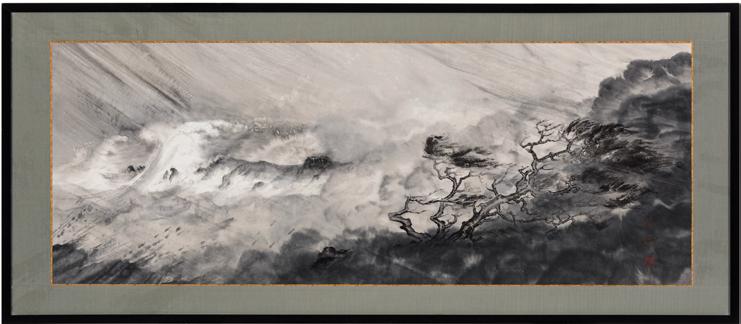

25
Center image: Shozo Sato, Fury of the Pacific , 1994. Blue tone ink, standard ink, and silver pigment on sized, pre-mounted paper.
DANCE IMPLEMENTS NEW CURRICULUM: A STUDENT PERSPECTIVE
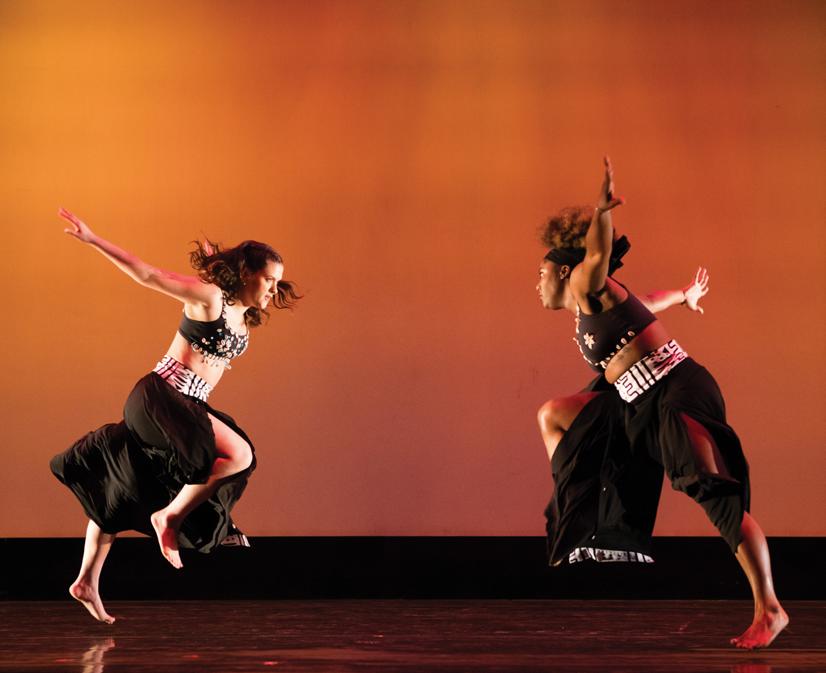 BY NAWAL ASSOUGDAM (BA ’25 DANCE)
BY NAWAL ASSOUGDAM (BA ’25 DANCE)
The Department of Dance implemented a new, long overdue redesigned curriculum this past academic year. By breaking down the barriers of an outdated curriculum that was built on a traditional conservatory model and rooted in systemic racism, its faculty and students now have the freedom and flexibility to pursue other forms of dance in their research and teaching.


Transitioning to the ever-evolving new curriculum has been far from easy. As a community, we have been challenged to adapt, inquire, fail, and persevere. We are growing to become versatile dancers trained in diverse styles while exploring various cultures and perspectives –developing our own sense of artistry. As a student in the burgeoning BA + BS Kinesiology dual degree, I approach my kinesiology studies through a dance context and utilize the information I learn to enhance my dancing. I am beginning to engage in my own research combining the two subjects.
This year, I recognized a tremendous amount of growth in my technique and choreography, gained an immense appreciation of the importance of culture and tradition in dance experiences, and honed my critical thinking skills allowing me to make connections between all areas of study. It is through the relationships I’ve built with the Dance at Illinois community that I have found a sense of stability. If we continue to offer each other mutual support amongst the challenges associated with an evolving curriculum, I am confident that we will rise to be the best dancers we can be.
The reimagined Dance curriculum better reflects Illinois’s role as a leading land-grant research university by exposing students to a global spectrum of aesthetics and dance forms to include contemporary African dance forms and diasporic dance, as well as urban social dance forms such as Hip Hop, House, and Vogue. Prioritizing inclusivity for all, the department will continue to shift away from a one-size-fits-all standard of pedagogy and champion the support of a much wider breadth of dance research and collaboration across the department.
Anna Lillig (BFA ’25) and Genesis Medious (BFA ’24) in Assistant Professor Dr. C. Kemal Nance’s Haba Na Haba Hujaza Kibaba
Photo by Natalie Fiol.
Professor Alexandra Barbier in her self-choreographed solo I’ll Never Be Beyonce.
Photo by Natalie Fiol.
Choreographer, composer and dancer Nawal Assougdam, right, is joined by dancers Sophie Philbrick (BME Music Education ’26), left, and Yuno Kimura (BFA ’26), center. Photo by Fred Zwicky, UI Public Affairs.
Historic Downtown Champaign Venue Opens Its Doors to Krannert Center
 BY SEAN KUTZKO, KRANNERT CENTER
BY SEAN KUTZKO, KRANNERT CENTER
Residents of ChampaignUrbana were given a treat when two of its great venues came together last spring as Krannert Center for the Performing Arts and Champaign’s historic Virginia Theatre combined efforts to present performances by the University of Illinois Urbana-Champaign’s Department of Dance and the School of Music’s Lyric Theatre. The results were exceptional on many levels.
Krannert Center opened in 1969 and has been not only a world-renowned venue for a full spectrum of national and international artists but also an educational hub for the Departments of Dance and Theatre and the School of Music including Lyric Theatre at Illinois. This blending of educational and professional performing arts is one of the hallmarks of Krannert Center.
The Virginia Theatre opened in Champaign in 1921 and has offered everything from vaudeville, theatre, and movies to concerts, comedies, and recitals. In private hands for most of its existence, it functioned primarily as a movie theatre from the 1930s through the 1980s. The venue was purchased by the non-profit Virginia Theatre Group in the 1990s, with the Champaign Park District taking over management in the early 2000s. Since then, the Virginia has hosted popular music concerts by nationally recognized musicians and has been a prime venue for many organizations and events such as the Champaign Urbana Ballet, the Champaign-Urbana Symphony Orchestra, and Roger Ebert’s Film Festival, among others.
With so many artists and performers in ChampaignUrbana, it came as a surprise to many that the Virginia Theatre and Krannert Center had not worked together in a very long time. Julie Gunn, professor of accompanying at the School of Music and codirector of Lyric Theatre at Illinois, recalled a 2022 meeting where they first discussed collaboration: “Steven Bentz, the executive director at the Virginia Theatre, shared that the Virginia’s 100th anniversary was approaching and that he was interested in developing new kinds of work for it. We recognized that this would be a great partnership.” The missing piece fell into place when Krannert Center announced their Colwell Playhouse would undergo major renovations for accessibility upgrades.
With the Playhouse shut down, an additional venue was needed for student productions. The Virginia Theatre opened its doors to host Krannert Center at the Virginia: Dance at Illinois Downtown and Lyric Theatre’s production of the Tony Awardwinning musical City of Angels. Dance at Illinois Downtown included works by Dance faculty, graduate students, and the legendary choreographer Kariamu Welsh, as well as performances by students, faculty, alumni guests, and local musicians. City of Angels, which was influenced by film noir and classic hard-edged detective movies, featured a jazz band comprised of local musicians, many of them part of the School of Music’s jazz program.
“We were excited to finally work with Krannert Center,” Mitch Marlow, sales and publicity manager at the Virginia Theatre, explained. “I received wonderful feedback from the productions’ faculty and staff about the historic beauty of the Virginia. It’s always gratifying to receive compliments [about the theatre], but it carries a bit more weight when coming from contemporaries in your field.”
There were significant logistical challenges to overcome. Students in Krannert Center’s Level 21 program, which
focuses on instruction in performing arts design, technology, and management, worked side by side with IATSE
Local 482 stagehands at the Virginia to rehearse and run the performances. Working in a non-university performance space helped students learn other aspects of real-world theatre production: “The union contracts at the Virginia Theatre limit the number of hours in the theatre each day, which taught our students about professional preparation to maximize every minute of rehearsal,” Gunn added.
The performances were a treat on both sides of the curtain. “I loved seeing the audience’s reaction to our work,” said Sara Hook, head of Dance at Illinois.
“I really enjoyed that it was a diverse audience and that there were many people there who don’t normally come to our shows. I heard from many Virginia regulars who had never been to a Dance production before, and they were over the moon about the experience they had!”
Julie Gunn enjoyed seeing the City of Angels cast grow from their Virginia Theatre experience. “Krannert Center will always be our artistic home, but when we can tour – to Allerton, New York City, Chicago, or downtown Champaign – I feel very good about what that accomplishes in relationship building and the development of flexible skills.”
This collaboration has opened the doors for further partnership as Illinois Theatre will take to the Virginia to present Jonathan Larson’s RENT October 26–28, 2023.
“We certainly hope there will be opportunities for more collaborations beyond these three productions,” Marlow added.
“I am definitely open to that,” Sara Hook said. “We loved being there. It is a beautiful, historic venue, and it felt wonderful to be right downtown. Besides, the educational experience for our students to work in a real-world environment like the Virginia Theatre is tremendous; it can’t be overstated.”
27
Office of Advancement
210B Architecture Building, MC-622
608 East Lorado Taft Drive
Champaign, IL 61820
OCT 26–28
Virginia Theatre
Jonathan Larson’s Tony and Pulitzer Prize winning musical RENT follows a year in the lives of young artists seeking connections, navigating political instability, mourning losses, and facing the relentless toll of the AIDS virus. Full of songs, sex, and celebration, RENT re-envisions Puccini’s classic La Bohéme for a Gen X world. RENT opens a door to the past, challenging us to move boldly forward. Tickets are on sale now at thevirginia.org
Directed by Lisa Gaye Dixon and JW Morrissette Music directed by Justin M. Brauer
Choreographed by Alexandra Barbier


KRANNERT CENTER AT THE VIRGINIA PRESENTS RENT
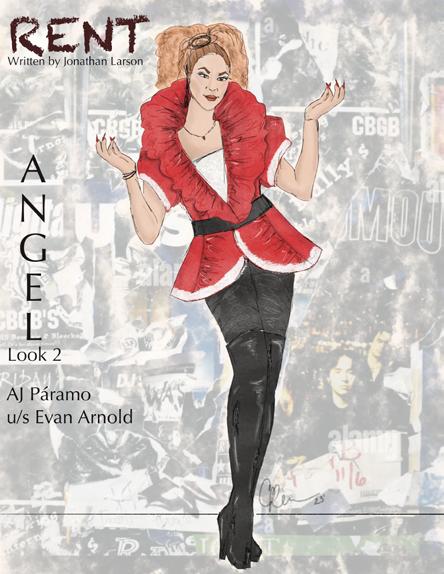 Chantel Renee, MFA student in Costume Design, reimagines RENT’s iconic Angel through three different looks in these costume renderings.
Chantel Renee, MFA student in Costume Design, reimagines RENT’s iconic Angel through three different looks in these costume renderings.






 BY MARIANA SEDA
BY MARIANA SEDA








 BY AMY KARAGIANNAKIS
BY AMY KARAGIANNAKIS
 Community members, faculty, and students work together to build the Quadoqté Cultural Center in Los Pumitas Neighborhood of Rosario, Argentina.
Gathered at the IMC zine library, the students worked on making their own zines addressing personal ethics, values, and positionalities.
The City Through the Body class members during their final projects public showcase.
Community members, faculty, and students work together to build the Quadoqté Cultural Center in Los Pumitas Neighborhood of Rosario, Argentina.
Gathered at the IMC zine library, the students worked on making their own zines addressing personal ethics, values, and positionalities.
The City Through the Body class members during their final projects public showcase.


 BY MARIANA SEDA
BY MARIANA SEDA








 Patrick Hill (BA rch ’70, MS ’72) LA NAPOULE
La Napoule, Place de La Fontaine. Photo by Patrick Hill.
Studio on the top floor with Patrick’s desk in the foreground.
Patrick Hill (BA rch ’70, MS ’72) LA NAPOULE
La Napoule, Place de La Fontaine. Photo by Patrick Hill.
Studio on the top floor with Patrick’s desk in the foreground.




















 BY TRACY CRANE AND AMY KARAGIANNAKIS
BY TRACY CRANE AND AMY KARAGIANNAKIS











 Recruitment flyer for the newly established Graphic Design graduate program at the University of Illinois (1965).
Recruitment piece for the Federal Reserve Board designed by Barry Huber.
Cover of the program Huber designed for the 1986 National Symphony Orchestra Ball held in Washington, D.C., and sponsored by Australia.
Recruitment flyer for the newly established Graphic Design graduate program at the University of Illinois (1965).
Recruitment piece for the Federal Reserve Board designed by Barry Huber.
Cover of the program Huber designed for the 1986 National Symphony Orchestra Ball held in Washington, D.C., and sponsored by Australia.




 BY AMY KARAGIANNAKIS
BY AMY KARAGIANNAKIS


 BY NAWAL ASSOUGDAM (BA ’25 DANCE)
BY NAWAL ASSOUGDAM (BA ’25 DANCE)


 BY SEAN KUTZKO, KRANNERT CENTER
BY SEAN KUTZKO, KRANNERT CENTER


 Chantel Renee, MFA student in Costume Design, reimagines RENT’s iconic Angel through three different looks in these costume renderings.
Chantel Renee, MFA student in Costume Design, reimagines RENT’s iconic Angel through three different looks in these costume renderings.